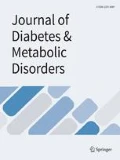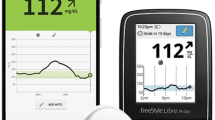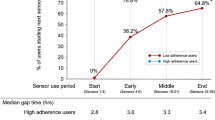Abstract
Purpose
This study explored early experiences with a flash glucose monitoring system among adolescents and young adults with type 1 diabetes and high-risk glycemic control.
Methods
Adolescents and young adults with high-risk glycemic control (HbA1c ≥ 75 mmol/mol (9.0%) in the previous 6 months) who had recently commenced on flash glucose monitoring as part of a trial took part in a semi-structured interview exploring their experiences with the technology. All interviews were recorded, transcribed and analyzed using an inductive approach.
Results
Fifteen interviews were conducted. Overall, participants enjoyed flash glucose monitoring and planned to continue using their system. Key findings included flash glucose monitoring reduced diabetes management burden and increased glucose monitoring. Other impacts of flash glucose monitoring use included perceived improved mood and energy, increased capacity for physical activity and less parental conflict. While participants reported healthier glycemic control, participants’ mean interstitial glucose level remained above the target range of 3.9–10.0 mmol/L (70–180 mg/dL) over the first month of flash glucose monitoring. Common challenges included premature sensor loss and decreased scanning over the first month of use.
Conclusions
Flash glucose monitoring may be an acceptable self-management tool to increase monitoring frequency in adolescents and young adults with type 1 diabetes and high-risk glycemic control, with the potential to improve long-term glycemic control. Initial support efforts should focus on practical strategies to prolong sensor wear and motivate frequent scanning as well as education on interpreting glucose data and making informed treatment decisions to maximize the benefits of this technology.
Similar content being viewed by others
References
Hanghøj S, Boisen KA. Self-reported barriers to medication adherence among chronically ill adolescents: a systematic review. J Adolesc Health. 2014;54(2):121–38.
King PS, Berg CA, Butner J, Butler JM, Wiebe DJ. Longitudinal trajectories of parental involvement in type 1 diabetes and adolescents’ adherence. Health Psychol. 2014;33(5):424–32.
Datye KA, Moore DJ, Russell WE, Jaser SS. A review of adolescent adherence in type 1 diabetes and the untapped potential of diabetes providers to improve outcomes. Curr Diab Rep. 2015;15(8):51.
Di Battista AM, Hart TA, Greco L, Gloizer J. Type 1 diabetes among adolescents. Diabetes Educ. 2009;35(3):465–75.
Clements MA, Foster NC, Maahs DM, Schatz DA, Olson BA, Tsalikian E, et al. Hemoglobin A1c (HbA1c) changes over time among adolescent and young adult participants in the T1D exchange clinic registry. Pediatr Diabetes. 2016;17(5):327–36.
Foster NC, Beck RW, Miller KM, Clements MA, Rickels MR, DiMeglio LA, et al. Network ftTDEC. State of type 1 diabetes management and outcomes from the T1D exchange in 2016–2018. Diabetes Technol Ther. 2019;21(2):66–72.
Phelan H, Clapin H, Bruns L, Cameron FJ, Cotterill AM, Couper JJ, et al. The Australasian diabetes data network: first national audit of children and adolescents with type 1 diabetes. Med J Aust. 2017;206(3):121–5.
Mohsin F, Craig ME, Cusumano J, Chan AK, Hing S, Lee JW, et al. Discordant trends in microvascular complications in adolescents with type 1 diabetes from 1990 to 2002. Diabetes Care. 2005;28(8):1974–80.
Diabetes Control and Complications Trial/Epidemiology of Diabetes Interventions and Complications Research Group. Sustained effect of intensive treatment of type 1 diabetes mellitus on development and progression of diabetic nephropathy: the epidemiology of diabetes interventions and complications (EDIC) study. JAMA. 2003;290(16):2159–67.
Donaghue KC, Fung AT, Hing S, Fairchild J, King J, Chan A, et al. The effect of prepubertal diabetes duration on diabetes: microvascular complications in early and late adolescence. Diabetes Care. 1997;20(1):77–80.
DiLiberti JH, Lorenz RA. Long-term trends in childhood diabetes mortality: 1968–1998. Diabetes Care. 2001;24(8):1348–52.
Miller KM, Beck RW, Bergenstal RM, Goland RS, Haller MJ, McGill JB, et al. T1D Exchance clinic network. Evidence of a strong association between frequency of self-monitoring of blood glucose and hemoglobin A1c levels in T1D exchange clinic registry participants. Diabetes Care. 2013;36:2009–14.
DiMeglio LA, Acerini CL, Codner E, Craig ME, Hofer SE, Pillay K, et al. Glycemic control targets and glucose monitoring for children, adolescents, and young adults with diabetes. Pediatr Diabetes. 2018;2018:19,105–14.
Saoji N, Palta M, Young HN, Moreno MA, Rajamanickam V, Cox ED. The relationship of type 1 diabetes self-management barriers to child and parent quality of life: a US cross-sectional study. Diabet Med. 2018;35(11):1523–30.
Carroll AE, Downs SM, Marrero DG. What adolescents with type 1 diabetes and their parents want from testing technology - a qualitative study. Comput Inform Nurs. 2007;25(1):23–9.
Heinemann L, Freckmann G. CGM versus FGM; or, continuous glucose monitoring is not flash glucose monitoring. J Diabetes Sci Technol. 2015;9(5):947–50.
Dunn TC, Xu Y, Hayter G, Ajjan RA. Real-world flash glucose monitoring patterns and associations between self-monitoring frequency and glycaemic measures: a European analysis of over 60 million glucose tests. Diabetes Res Clin Pract. 2018;137:37–46.
Campbell F, Bolinder J. FreeStyle Libre™ use for self-management of diabetes in teenagers and young adults. Diabetes. 2018;67(Supplement 1):158–LB.
Campbell FM, Murphy NP, Stewart C, Biester T, Kordonouri O. Outcomes of using flash glucose monitoring technology by children and young people with type 1 diabetes in a single arm study. Pediatr Diabetes. 2018;19(7):1294–301.
Bolinder J, Antuna R, Geelhoed-Duijvestijn P, Kröger J, Weitgasser R. Novel glucose-sensing technology and hypoglycaemia in type 1 diabetes: a multicentre, non-masked, randomised controlled trial. Lancet. 2016;388(10057):2254–63.
Rachmiel M, Landau Z, Boaz M, Aronovitch KM, Loewenthal N, Ben-Ami M, et al. The use of continuous glucose monitoring systems in a pediatric population with type 1 diabetes mellitus in real-life settings: the AWeSoMe study group experience. Acta Diabetol. 2015;52(2):323–9.
Vesco AT, Jedraszko AM, Garza KP, Weissberg-Benchell J. Continuous glucose monitoring associated with less diabetes-specific emotional distress and lower A1c among adolescents with type 1 diabetes. J Diabetes Sci Technol. 2018;12(4):792–9.
Myron L, Holmes-Walker J, Farrell K. The impact of continuous glucose monitoring in youth with type 1 diabetes, aged 16–21. Diabetes. 2019;68(Supplement 1).
Vergier J, Samper M, Dalla-Vale F, Ventura V, Baucher F, Joubert F, et al. Evaluation of flash glucose monitoring after long-term use: a pediatric survey. Prim Care Diabetes. 2019;13(1):63–70.
Al Hayek AA, Robert AA, Al Dawish MA. Evaluation of FreeStyle libre flash glucose monitoring system on glycemic control, health-related quality of life, and fear of hypoglycemia in patients with type 1 diabetes. Clin Med Insights Endocrinol Diabetes. 2017;10:1179551417746957.
Rewers MJ, Pillay K, De Beaufort C, Craig ME, Hanas R, Acerini CL, et al. Assessment and monitoring of glycemic control in children and adolescents with diabetes. Pediatr Diabetes. 2014;15(S20):102–14.
Franklin V. Influences on technology use and efficacy in type 1 diabetes. J Diabetes Sci Technol. 2016;10(3):647–55.
Boucher SE, Gray AR, de Bock M, Wiltshire EJ, Galland BC, Tomlinson PA, et al. Effect of 6 months’ flash glucose monitoring in adolescents and young adults with type 1 diabetes and suboptimal glycaemic control: managing diabetes in a ‘flash’ randomised controlled trial protocol. BMC Endocr Disord. 2019;19(1):50.
Thomas DR. A general inductive approach for analyzing qualitative evaluation data. Am J Eval. 2006;27(2):237–46.
Edge J, Acerini C, Campbell F, Hamilton-Shield J, Moudiotis C, Rahman S, et al. An alternative sensor-based method for glucose monitoring in children and young people with diabetes. Arch Dis Child. 2017;102(6):543–9.
DiMatteo MR, Haskard-Zolnierek KB, Martin LR. Improving patient adherence: a three-factor model to guide practice. Health Psychol Rev. 2012;6(1):74–91.
Davidson M, Penney ED, Muller B, Grey M. Stressors and self-care challenges faced by adolescents living with type 1 diabetes. Appl Nurs Res. 2004;17(2):72–80.
Hains AA, Berlin KS, Davies WH, Parton EA, Alemzadeh R. Attributions of adolescents with type 1 diabetes in social situations: relationship with expected adherence, diabetes stress, and metabolic control. Diabetes Care. 2006;29(4):818–22.
Borus JS, Laffel L. Adherence challenges in the management of type 1 diabetes in adolescents: prevention and intervention. Curr Opin Pediatr. 2010;22(4):405–11.
Dickinson JK, O’Reilly MM. The lived experience of adolescent females with type 1 diabetes. Diabetes Educ. 2004;30(1):99–107.
Wood JR, Miller KM, Maahs DM, Beck RW, DiMeglio LA, Libman IM, et al. Most youth with type 1 diabetes in the T1D exchange clinic registry do not meet American Diabetes Association or International Society for Pediatric and Adolescent Diabetes clinical guidelines. Diabetes Care. 2013;36(7):2035–7.
Miller KM, Foster NC, Beck RW, Bergenstal RM, DuBose SN, DiMeglio LA, et al. Current state of type 1 diabetes treatment in the U.S.: updated data from the T1D exchange clinic registry. Diabetes Care. 2015;38(6):971–8.
Bandura A. Self-efficacy. In: Weiner IB, Craighead WE, editors. The Corsini encyclopedia of psychology. 4th ed. New Jersey: Wiley & Sons, Inc; 2010. Available from. https://doi.org/10.1002/9780470479216.corpsy0836.
Agiostratidou G, Anhalt H, Ball D, Blonde L, et al. Standardizing clinically meaningful outcome measures beyond HbA1c for type 1 diabetes: a consensus report of the American Association of Clinical Endocrinologists, the American Association of Diabetes Educators, the American Diabetes Association, the Endocrine Society, JDRF international, the Leona M. and Harry B. Helmsley Charitable Trust, the pediatric Endocrine Society, and the T1D exchange. Diabetes Care. 2017;40(12):1622–30.
Boucher S, Aum SH, Crocket H, Wiltshire E, Tomlinson P, de Bock M, et al. Exploring parental perspectives following commencement of flash glucose monitoring for type 1 diabetes in adolescents and young adults not meeting glycaemic targets: a qualitative study. Diabet Med. In press.
Wysocki T, Harris MA, Greco P, Bubb J, Danda CE, Harvey LM, et al. Randomized, controlled trial of behavior therapy for families of adolescents with insulin-dependent diabetes mellitus. J Pediatr Psychol. 2000;25(1):23–33.
Wheeler BJ, Braund R, Galland B, Mikuscheva A, Wiltshire E, Jefferies C, et al. District health board of residence, ethnicity and socioeconomic status all impact publicly funded insulin pump uptake in New Zealand patients with type 1 diabetes. N Z Med J. 2019;132(1491):78–89.
McKergow E, Parkin L, Barson DJ, Sharples KJ, Wheeler BJ. Demographic and regional disparities in insulin pump utilization in a setting of universal funding: a New Zealand nationwide study. Acta Diabetol. 2017;54(1):63–71.
Acknowledgements
The authors wish to thank the participants for their involvement in this research.
Funding
This work was supported by Cure Kids (grant number 3582), Dunedin School of Medicine, and New Zealand Society for the Study of Diabetes (NZSSD). Funders were not involved in the study design; in the collection, analysis and interpretation of data; in writing of the report; and in the decision to submit the article for publication.
Author information
Authors and Affiliations
Contributions
SB contributed to the concept and design, acquisition of data, analysis and interpretation of the data, drafting and revising the article. MB contributed to the acquisition of data, analysis and interpretation of the data, drafting and revising the article. BG contributed to the concept and design, supervising acquisition of data, and revising the article critically for important intellectual content. MdB, EW, PT and JR contributed to the concept and design, and revising the article for important intellectual content. HC contributed to the design, interpretation of the data, and revising the article for important intellectual content. BW contributed to the concept and design, supervising acquisition of data, interpretation of the data, drafting and revising the article. All authors contributed to editing the final manuscript and approved it for submission.
Corresponding author
Ethics declarations
Conflict of interest
The authors declare that they have no conflict of interest.
Additional information
Publisher’s note
Springer Nature remains neutral with regard to jurisdictional claims in published maps and institutional affiliations.
Rights and permissions
About this article
Cite this article
Boucher, S., Blackwell, M., Galland, B. et al. Initial experiences of adolescents and young adults with type 1 diabetes and high-risk glycemic control after starting flash glucose monitoring - a qualitative study. J Diabetes Metab Disord 19, 37–46 (2020). https://doi.org/10.1007/s40200-019-00472-5
Received:
Accepted:
Published:
Issue Date:
DOI: https://doi.org/10.1007/s40200-019-00472-5




